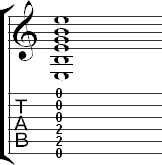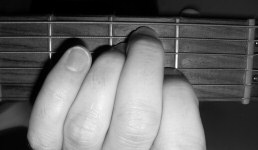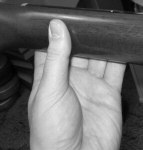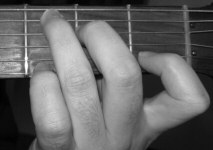How to Play Chords
What Is a Chord?
A chord is three or more notes played at the same time. Chords are used in nearly all Western music. Each chord is made of a certain combination of notes. The most important note in a chord is the root. The root of the chord is the same as the letter name of the chord. For example, the root of a C major chord is 'C'. Visit the music theory section to learn more about chord construction.
Learn about the music theory behind chords
How to Read Chord Diagrams
Guitar chords are generally notated with chord diagrams (also called charts). Here is a C major chord represented by a chord chart:

Parts of a Chord Diagram
Chord Name
The chord name is a letter (from A to G) and possibly other symbols depending on the type of chord. It is found above the diagram. There are many different chord names and some chords may be called by two or more names. Below are a few of the more common names and symbols and how to say the name of the chord.
- C: C major
- Cm: C minor
- C7: C seventh or C dominant seventh
- Cmaj7: C major seventh
- Cm7: C minor seventh
- C6: C sixth or C major sixth
All of the chords listed above have 'C' as a root. The root of the chord is the same pitch as the letter name of the chord.
Vertical and Horizontal Lines
The vertical lines in the diagram represent the six strings of the guitar starting with the first string on the right-most line.

Horizontal lines represent frets. The top line may be bold in some cases. This represents the nut on the guitar.
X or O at the Top of the Chart
An 'X' means that the string isn't played. An 'O' means that string is played open. Circles and zeroes are used interchangeably to mean the same thing.

Dots
Dots mean that you fret the string and fret where the dot appears.

Finger Numbers
Numbers at the top or bottom of the chart indicate which finger you use to finger the note on that string. You may occasionally see numbers on the diagram instead of dots rather than at the top or bottom of the diagram. These numbers also indicate which finger to use on that string and fret.

The fingers of the left hand are numbered as follows:
- 1 index
- 2 middle
- 3 ring
- 4 pinky
Fret Numbers
A number on the right side of the diagram indicates the fret where the chord is played. Some chord diagrams may use only a number while others may be written as a number plus "fr," which is an abbreviation for fret.

Barres
A curved line indicates a barre, which is a technique where you play several strings with the same finger. This is a more advanced technique that will be covered in future lessons on barre chords so you don't need to worry about it now.

Your First Chord
The first chord you will learn is the E minor chord. This is an easy chord to start with because it requires only two fingers and there are no difficult stretches involved.
E Minor Chord
Chord Diagram

Tablature

Below an example of the E minor chord being fretted:

Playing an E minor chord
General Tips for Playing Chords
Position of the Hand and Fingers
The thumb should be kept behind the neck and parallel to the frets.

Correct thumb position
The fingers should be curved and shouldn't collapse at the knuckle joint. Curving the fingers will make it easier to avoid muting other strings accidentally.

How to curve your fingers
Making Adjustments to Get a Clean Chord
Play each string in the chord to make sure that each string that is supposed to sound is ringing. If you get a muted or percussive sound, you need to adjust your positioning to that the string will ring. Try the following tips for adjusting your hand position:
- 1. Make sure that your fingers are curved in such a way that they avoid strings above or below. You should be playing with almost the tip of the finger to facilitate this.
- 2. Move your elbow away from or toward your body. This will sometimes make it easier to avoid inadvertently muting strings because it will change the angle of the fingers in relation to the strings.
- 3. Move your wrist out from the guitar or towards it. The motion should come primarily from the shoulder joint, but the effect will be to move the wrist in relation to the guitar neck. Doing this may allow fingers to clear strings that they were muting in another position.
- 4. Experiment with a combination of the tips above. Different chords benefit from slightly different positions of the fingers, wrist, and arm. It will take time to learn which position works best for each chord, but the process will become automatic with enough practice. There is no single correct position for each chord. This will vary from person to person and you need to practice to find what works for you. If the result is a chord where all the notes ring clearly and you are using proper technique, then the position is correct for you.

Comments
Fret the second fret of the fifth string with the middle finger and the second fret of the fourth string with the ring finger. Make sure you aren't muting the third string with your ring finger.